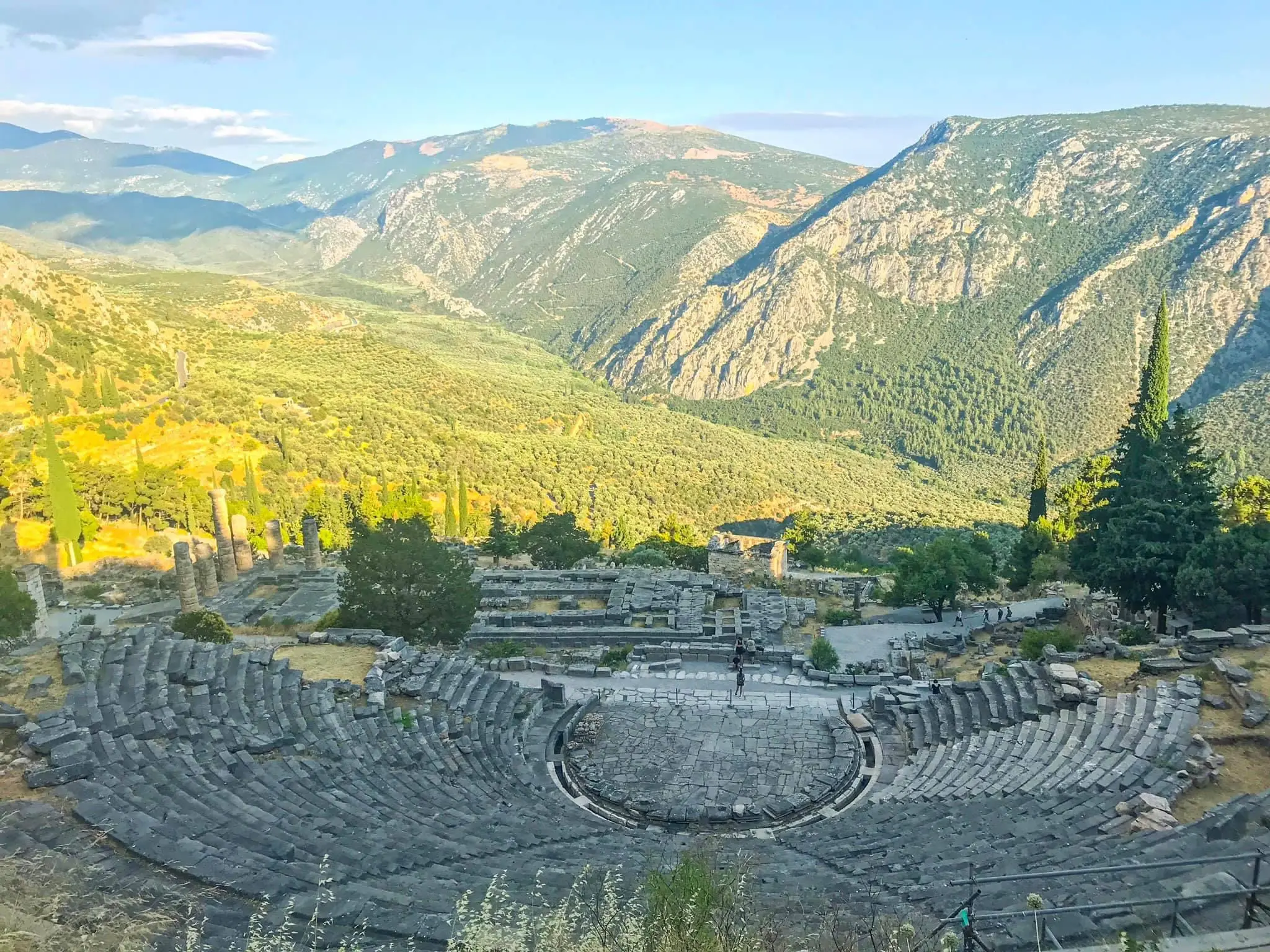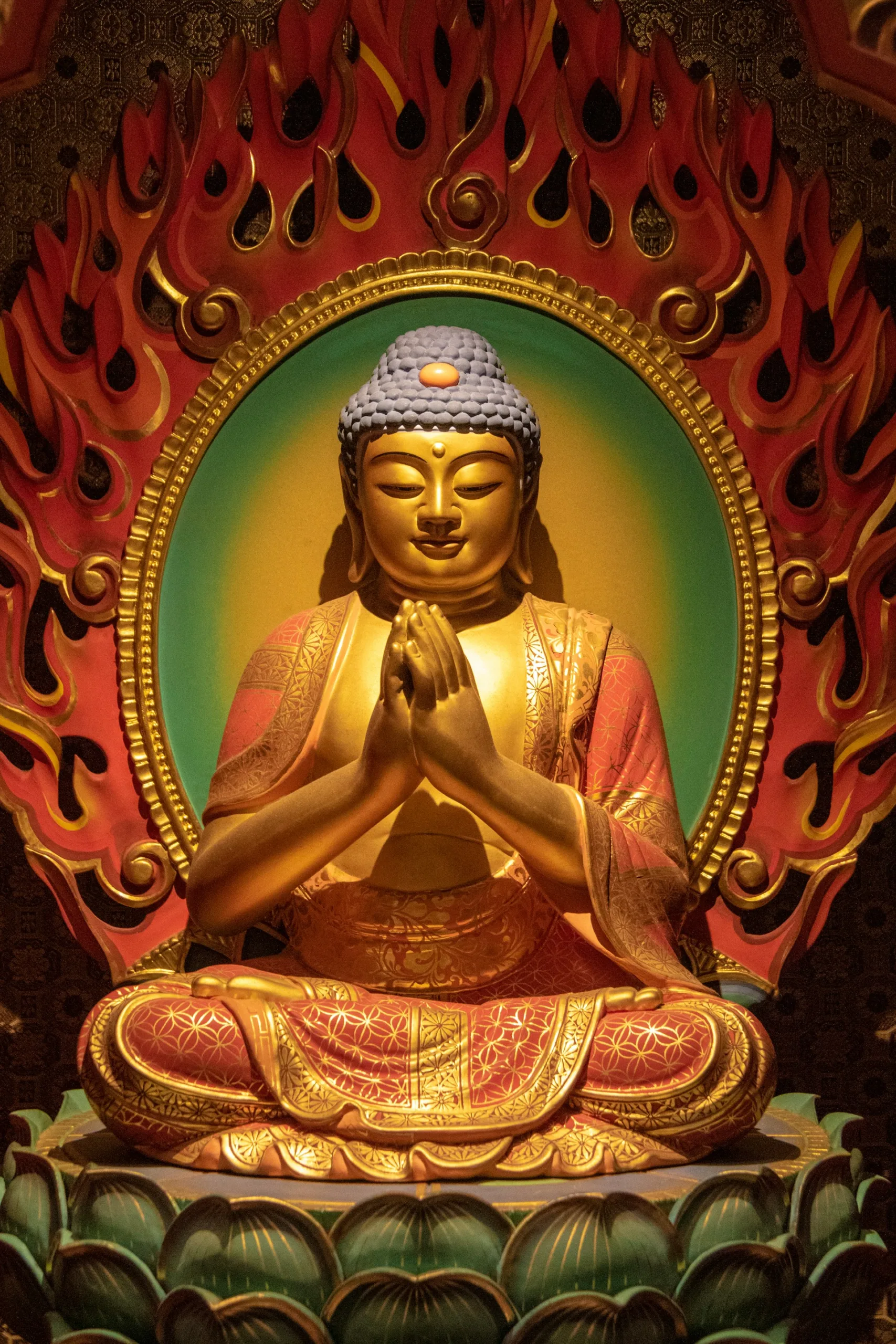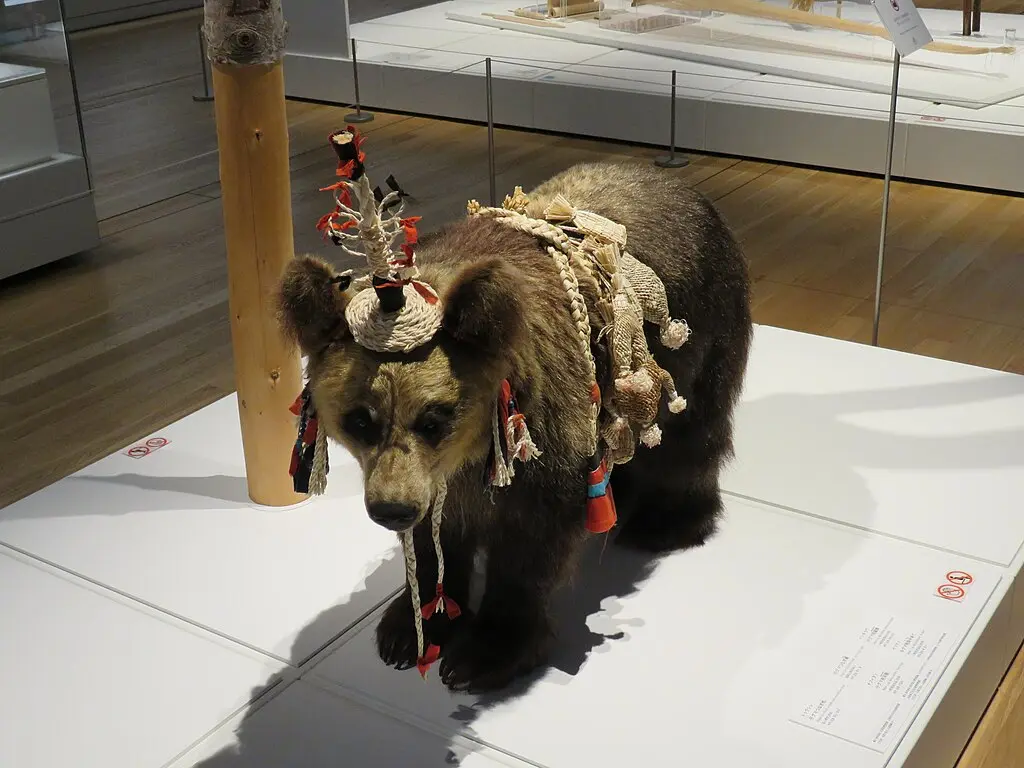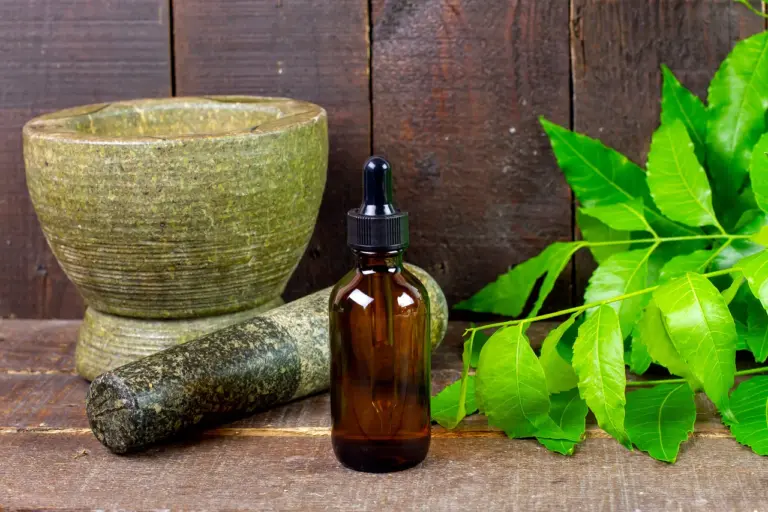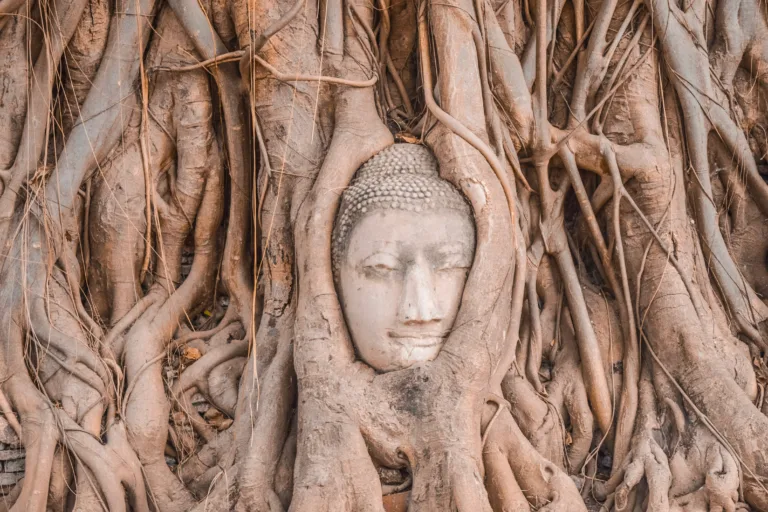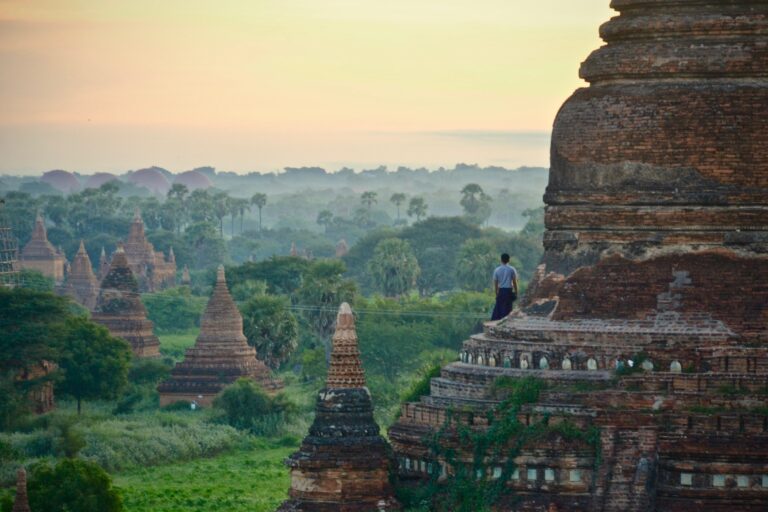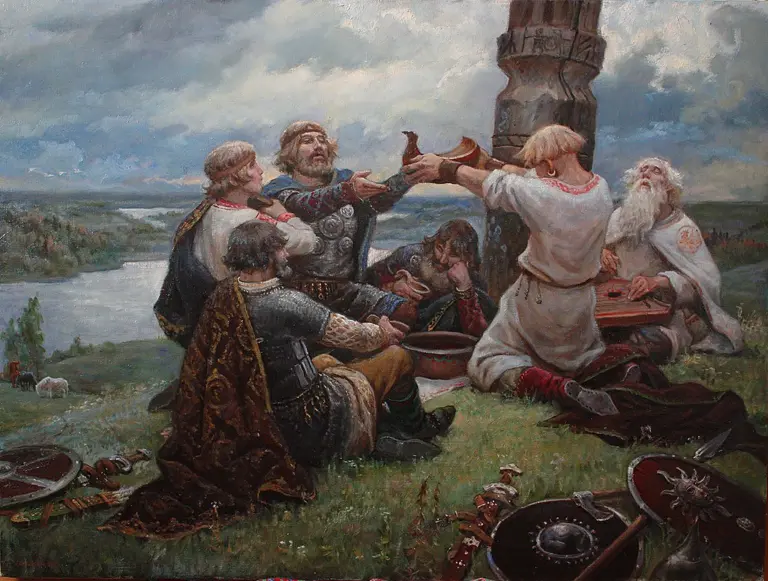The White Temple of Chiang Rai is a true masterpiece, blending traditional Thai architecture with unconventional contemporary design. This unique fusion of art and spirituality has quickly gained worldwide attention, drawing visitors from all across the globe.
When you step foot inside the temple grounds, keep your eyes peeled, get close, and you’ll see just how intricate every corner of the temple truly is.
From the myriad of hands surrounding the bridge, to the provocative golden toilet, every aspect of the White Temple is infused with symbolism and it’s all thanks to one brilliant mind!
In this article, we’ll take a deep dive into the fascinating facts and symbolisms of the White Temple. By the end, I hope you’ll have a richer appreciation of this extraordinary temple and the Buddhist teachings it represents.
Table of Contents
ToggleWhere is the White Temple?
The White Temple is located in the Chiang Rai province in northern Thailand. It is situated about 13 km south of the city center of Chiang Rai. The distance between Bangkok and Chiang Rai is approximately 800 km (500 mi) and Chiang Mai is located approximately 180 km (112 mi) southeast of Chiang Rai.
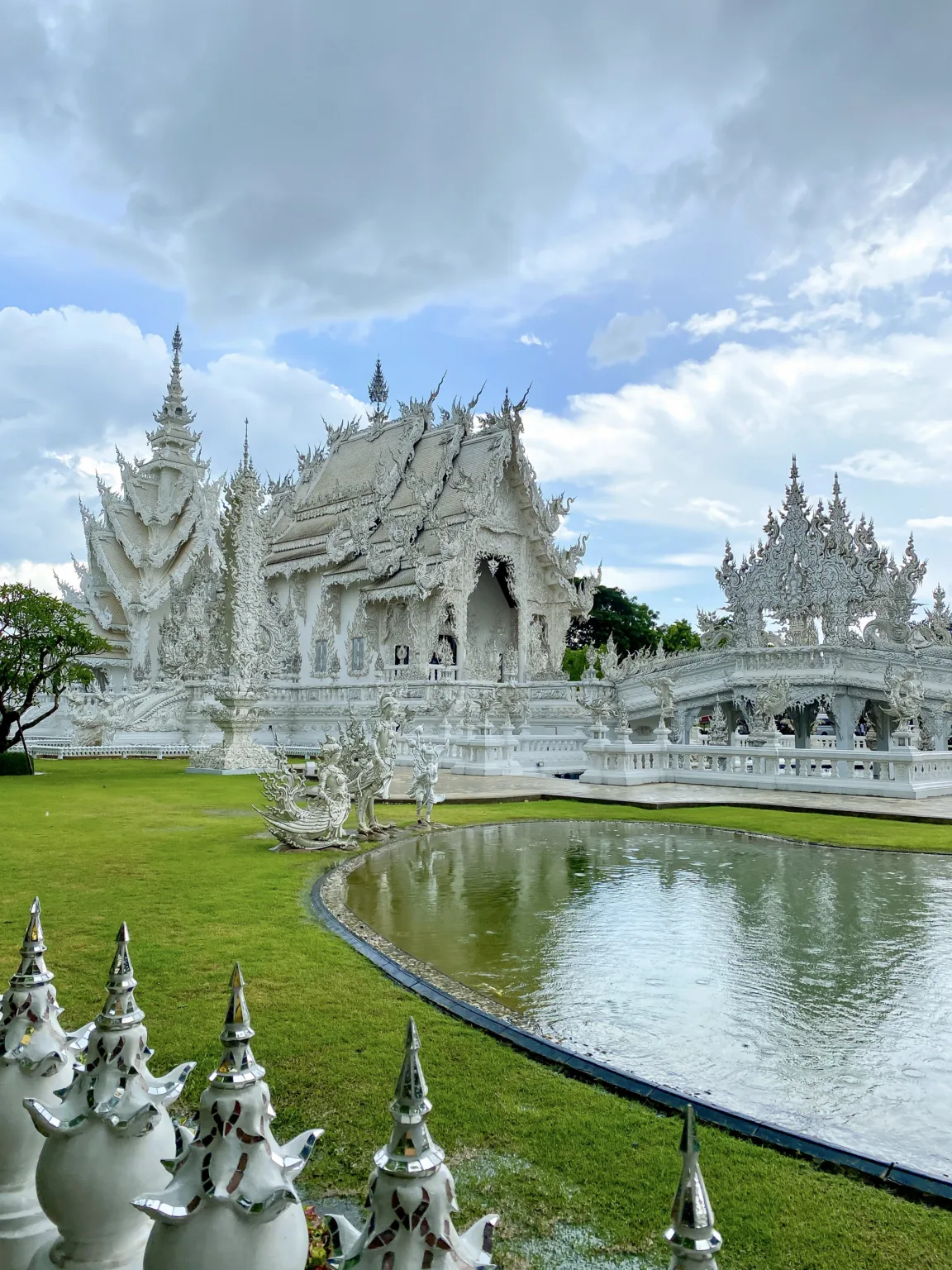
Is the White Temple Worth Visiting?
Absolutely! It’s one of the main draws of Chiang Rai and is a must-visit if you’re in the area. The White Temple is so significant that it’s become an icon for Chiang Rai and attracts thousands of visitors every year. It was definitely the highlight of Chiang Rai for us.The good thing for you is that it’s still relatively new and not a lot of people have heard about it yet so it’s the perfect chance to see it while it’s not yet overcrowded.
What makes the White Temple so special is its one-of-a-kind architecture. The entire temple complex is painted white, with sculptures adorning every surface, you’ll have to see it yourself to appreciate its beauty!
What to Know Before Visting the White Temple
Official Name: Wat Rong Khun
Location: White Temple
Opening Hours: 8:00 AM – 6:00 PM
Cost: 100 THB (3 USD)
What Do You Wear to the White Temple?
As with most Thai temples, you will have to dress modestly.
Dress Code: Shoulders and knees must be covered and shoes must be taken off before entering the main temple. You can still wear your shoes around the perimeter and the bridge area.
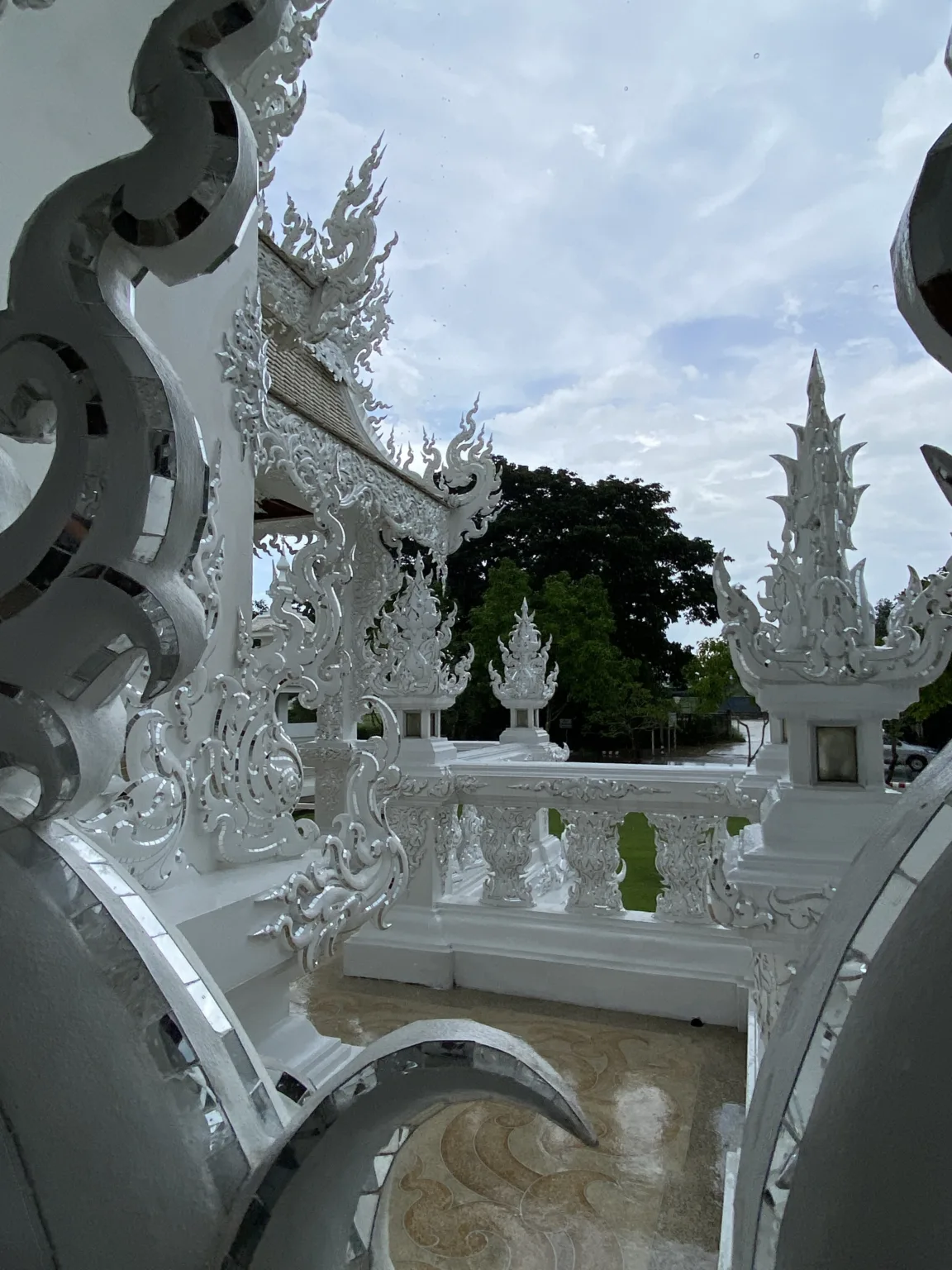
How to Get to the White Temple?
From Chiang Rai
- Bus: There are buses in Chiang Rai Bus Terminal 1 (look for the ones that have a “White Temple” tarp) that depart every 30 minutes from 10:00AM – 2:00 PM. One way takes around 20 minutes.
Cost: 20 THB (0.50 USD) - Taxi: Another convenient way is to use the Grab app to call a taxi to take you to the White Temple if you’re far from the bus terminal, this is what we did and the journey takes around 15 minutes or so.
Cost: 150 THB – 200 THB (5 – 6 USD) one way. - Tuktuk: Similar to a cab, you can also take a tuktuk to reach the White Temple which takes around 15-20 minutes.
Cost: 100 THB – 150 THB (3 USD – 5 USD) one way. - Tour: You can also join tours in Chiang Rai that go to the White Temple and other sights such as the Golden Triangle. You can find one here.
From Chiang Mai
- Bus: Buses depart regularly from Chiang Mai’s Arcade Bus Station and take around 3-4 hours to reach Chiang Rai Bus Terminal. From the bus terminal, take a taxi or tuktuk to the White Temple.
- Car: It’s very easy to drive from Chiang Mai to Chiang Rai if you have your ride but the journey still takes around 3-4 hours, you can get rental cars through here.
- Taxi: Alternatively, you can also hire a private car or taxi to take you. The journey takes around 3-4 hours.
- Tour: There are plenty of tours that depart from Chiang Mai to visit the White Temple and other sights in Chiang Rai, you can join one through here.
From Bangkok
- Plane: Bangkok is very far from Chiang Rai so the fastest way to get there is by air. It’s actually how we did it as we were coming from Bangkok. Flight time is around 1 hour and 30 minutes and you can make bookings through 12Go.
- Bus: Buses depart from the Mo Chit Bus Station in Bangkok and take around 11-12 hours to reach Chiang Rai Bus Terminal.
Where to Stay in Chiang Rai
Chiang Rai is a wonderful laid-back province with plenty of accommodations to suit your needs, here are some of my recommendations:
Best Hotels in Chiang Rai
- Pimann Inn Hotel – this is where we personally stayed and I must say it was more than enough for us. The air-conditioned rooms were spacious and quiet. The halls had a long koi pond extending both directions. Concierge service was good and they had a very huge pool. The location was also very good as it’s tucked in the heart of the city center.
- The Heritage Chiang Rai Hotel – a 5-star hotel that features an outdoor swimming pool, a fitness center, and a garden, as well as offering free private parking and free WiFi. The hotel also has a terrace with city views, a restaurant, and a bar.
- Blue Lagoon Hotel – offers shared lounge and concierge services, along with free WiFi. All rooms at the hotel come with air conditioning, a flat-screen cable TV, a fridge, an electric tea pot, a shower, free toiletries, and a desk. The private bathroom is equipped with a hairdryer and complimentary bed linen.
Best Hostels in Chiang Rai
- Mercy Hostel – located a little off the main road, providing a peaceful sleeping environment. Also features a terrace with a small reflecting pool and sunbathing mattresses. The hostel has only one floor, so there is no need to climb stairs. The 10 dormitory rooms are air-conditioned and come with individual lockers, individual lights, hotel-quality beds, and blankets.
- Backpack Hostel – offers express check-in and check-out, non-smoking rooms, and free WiFi throughout the property. The hostel features a terrace and a tour desk, and luggage storage service is available. The rooms at Backpack Hostel are equipped with air conditioning and shared bathrooms.
- Baan Mai Kradan Hostel – is a renovated old Thai house built in 1964, located in the downtown area of Chiang Rai. The hostel was opened in October 2017 and provides premium co-living accommodation. The hostel is situated just a few minutes’ walk from the famous Saturday Walking Street.
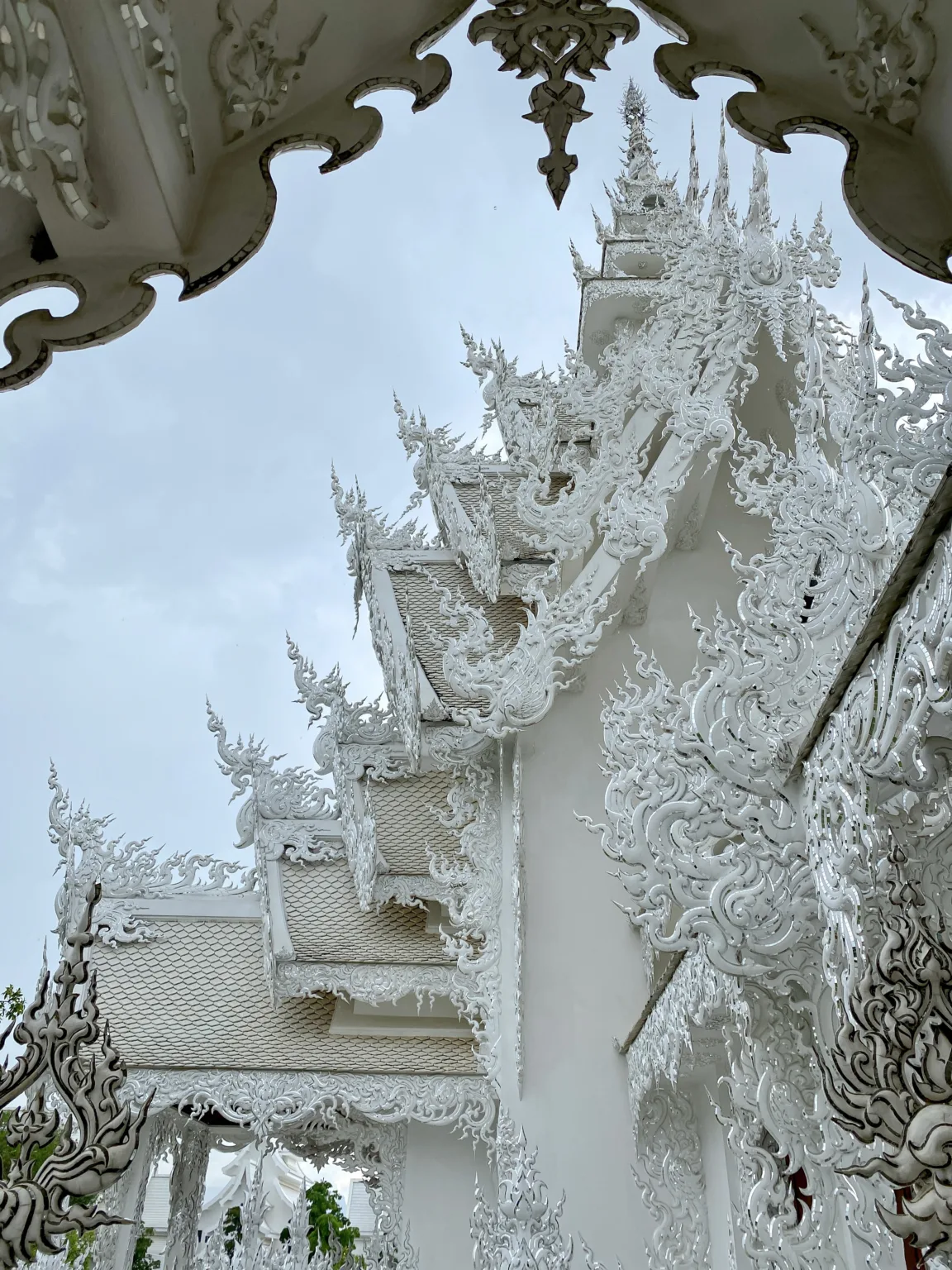
History of the White Temple
The White Temple is actually still a relatively new as with most of the popular sights around Chiang Rai, let’s go through its history:
1997: Construction of the main temple building begins.
2000: The main temple building is completed and opened to the public.
2004: The temple is damaged by an earthquake
2008: A new building, the Golden Toilet, is added to the temple complex.
2012: A new building, the Museum of Religious Arts, is added to the temple complex.
2014: The temple is damaged by a severe earthquake, and restoration work begins again.
2016: The temple is fully restored and reopened to the public.
Today, the works are still ongoing and it won’t be finished until 2070! We still have a lot more to expect from this amazing work of art!
White Temple Facts
1. Who Built the White Temple?
The White Temple was designed and built by a famous Thai artist named Chalermchai Kositpipat. Chalermchai was born in 1951 in the village of Rong Khun located in Chiang Rai.
Chalermchai funded the construction of the temple himself and has invested over 1,080 million THB (33 million USD), and over the years he has continued to add new buildings and features to the complex. Chalermchai’s devotion to the project is so strong that he has made plans for work to continue on the temple in the event of his death!
2. Why is it Called White Temple? (Meaning of Wat Rong Khun)
The name “White Temple” is a common English translation of the temple’s Thai name, as it accurately describes the temple’s striking white exterior.
“Wat Rong Khun” is actually the real name of the White Temple. “Wat” is a Thai word that means temple, while “Rong Khun” is the name of the village where the temple is located. “Rong” means building, while “Khun” is a Thai word that means white. So all together, we can literally translate “Wat Rong Khun” as “Temple of the White Building” or White Temple for short!
3. What is the White Temple Made of?
The White Temple is primarily made of a combination of white plaster and silver glass tiles. The exterior walls and roof of the temple are covered with a layer of white plaster, giving the temple its iconic white color.
White Temple’s ingenious use of glass creates the shimmering effect that’s really apparent as the sun rays hit. The main building features numerous small mirrors embedded in the plaster, giving the temple its signature otherworldly appearance.
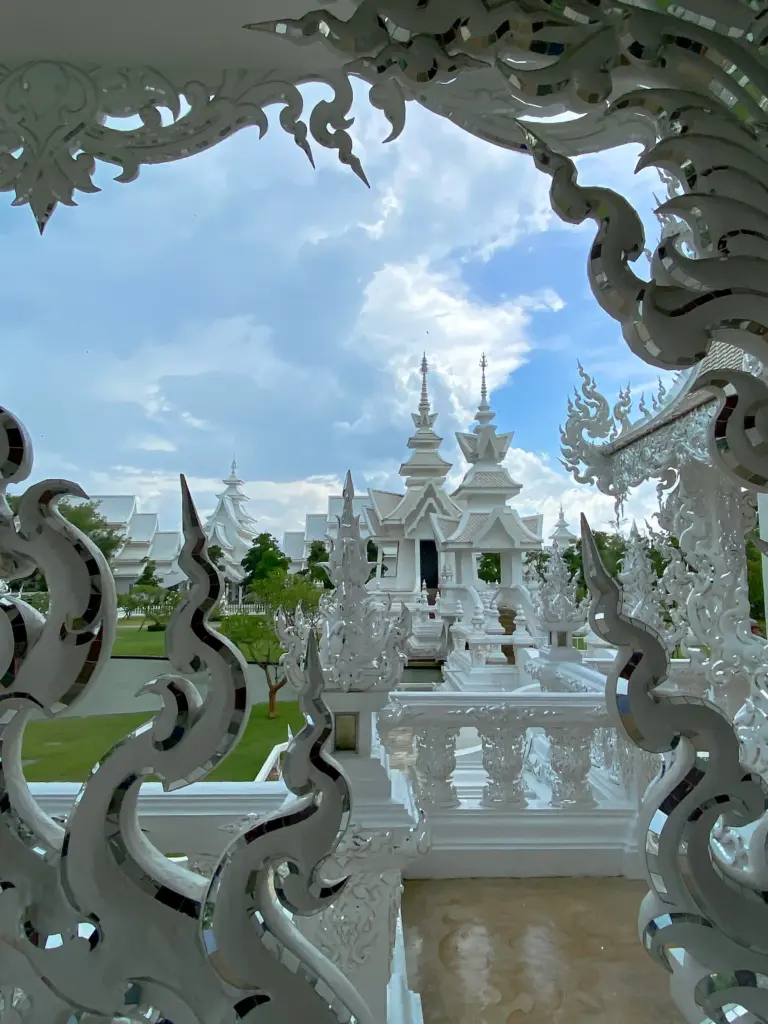
4. What is the Story of the White Temple?
Originally, the site where the temple now stands was home to an old temple that had fallen into disrepair. In 1997, the famous Thai artist Chalermchai Kositpipat decided to rebuild the temple and transform it into something that will last a lifetime.
Chalermchai’s vision for the White Temple is to create a work of art that will be a center of learning and meditation for people to gain benefit from Buddhist teachings. He considers the temple to be an offering to Lord Buddha and hopes that it will give him immortal life.
5. What Culture is the White Temple?
While the White Temple is predominantly considered as Thai culture, there are plenty of pop culture references scattered around the temple complex. They are there to convey a message of social and political commentary, as well as a reflection of the changing times and the impact of globalization on Thai culture.
Chalermchai’s vision for the temple was to create a contemporary work of art that would reflect the beauty of Buddhism, while also incorporating modern-day cultural references.
Take a closer look and you might notice that the temple’s murals include depictions of popular cultural icons such as Batman, Harry Potter, and Michael Jackson! You can also find political figures like George W. Bush and Osama bin Laden. You can even see the Predator hanging around!
6. What Religion is the White Temple?
The White Temple is primarily a Theravada Buddhist temple. Theravada Buddhism is the predominant form of Buddhism practiced in Thailand and other Southeast Asian countries. You can find my article that talks about the intricacies of Theravada Buddhism here.
Basically, Theravada Buddhism emphasizes the importance of the our spiritual journey and the attainment of enlightenment through the practice of meditation and the study of Buddhist teachings.
White Temple Symbolisms
7. The White
The color white symbolizes the purity of the Buddha, as well as the purity of the path towards enlightenment in Buddhism.
Moreover, the white color also represents the absence of worldly desires, which are important aspects of Buddhist teachings.
The temple’s architect, Chalermchai Kositpipat, has stated that the color white is meant to represent the Buddha’s radiant Dharma.
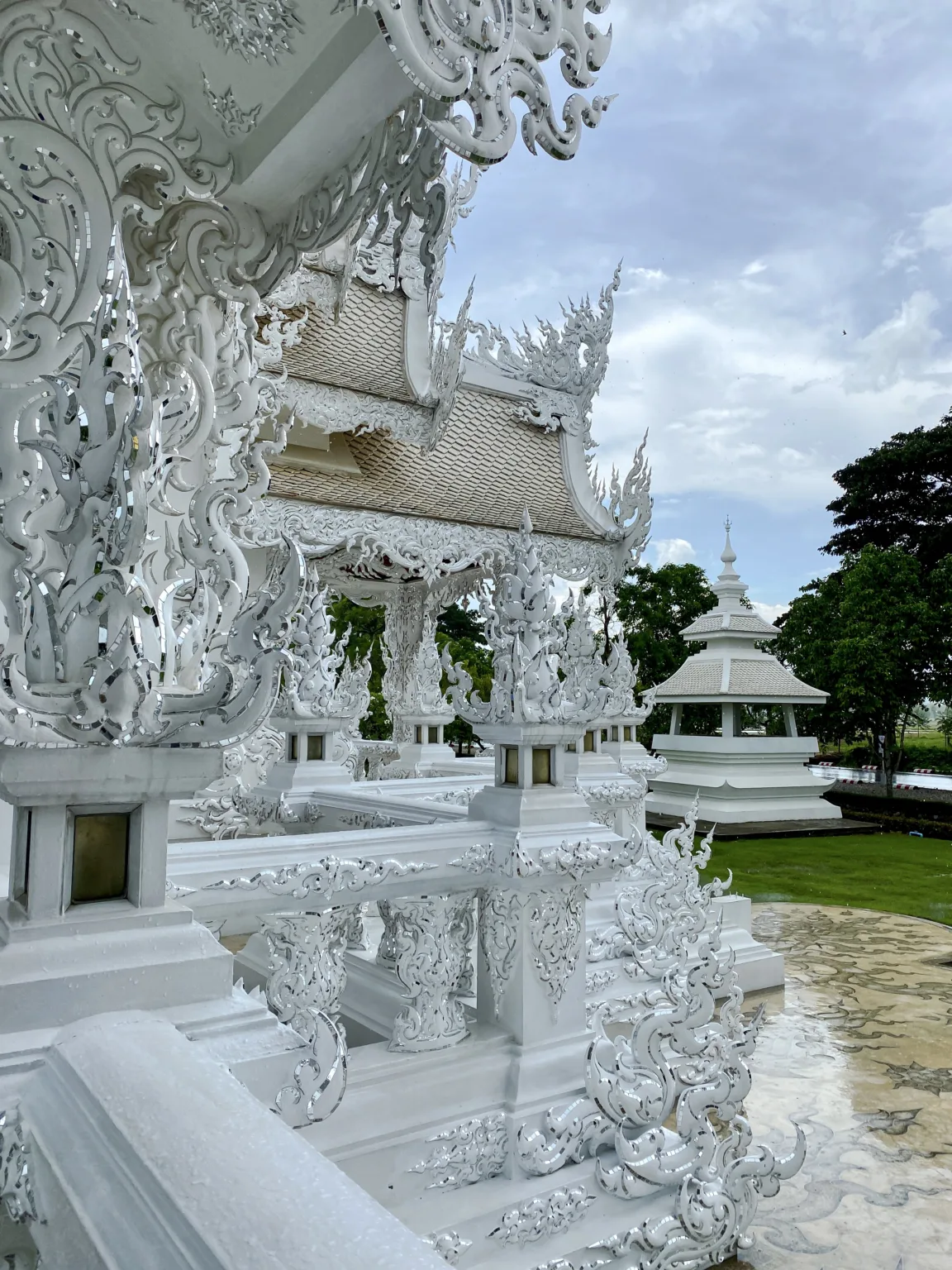
8. The Mirrors
The mirrors in the White Temple are meant to reflect the wisdom of the Buddha to the world and illuminate the darkness of ignorance. The use of mirrors is a symbolic representation of the Buddha’s teachings, which act as a reflection of reality to help us see the truth and attain enlightenment.
At the same time, the mirrors also symbolize the (very misunderstood) concept of emptiness in Buddhism, which highlights the illusory nature of existence. I try to explain the Buddhist concept of emptiness a bit simpler in this article.
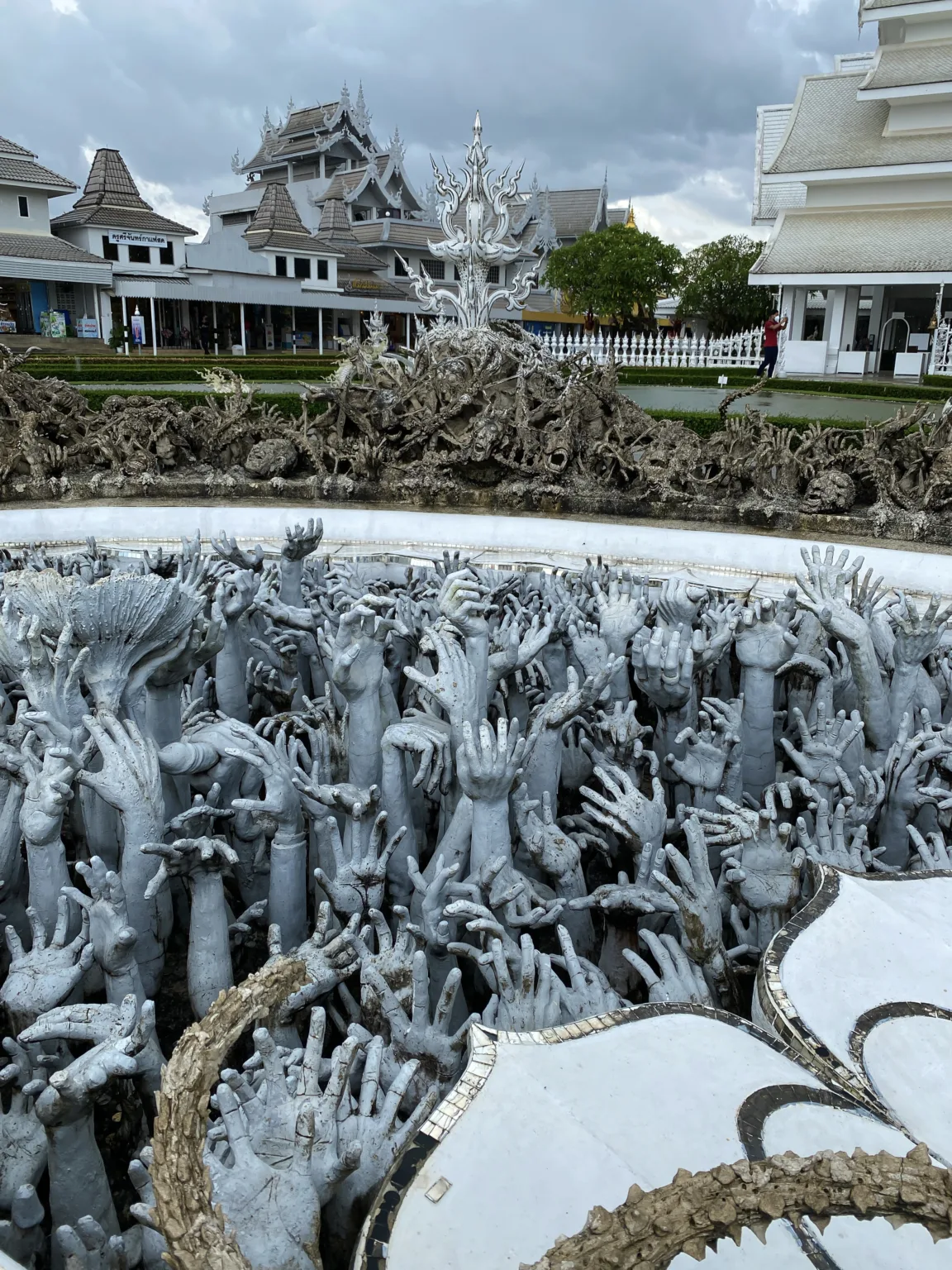
9. The Hands
The hands represent the desires and temptations that keep us in the cycle of death and rebirth. The main goal of Buddhism is to be free from this cycle that’s also known as “Samsara”.
You’ll get a chill up your spine as you cross the bridge. The hands are designed to be menacing, and they seem to be reaching up from the depths of hell to pull you down, look closer and you’ll even see some faces underneath, scary!
10. The Bridge of Rebirth
The journey across the Bridge of Rebirth is meant to represent the journey from ignorance to wisdom and the attainment of enlightenment.
While the hands symbolize the desires that lead us into the cycle of death and rebirth. As you cross the bridge, it’s meant to represent the overcoming of these temptations.
At the end of the bridge, you’ll reach the temple’s main hall, which houses a statue of the Buddha, symbolizing the attainment of enlightenment.
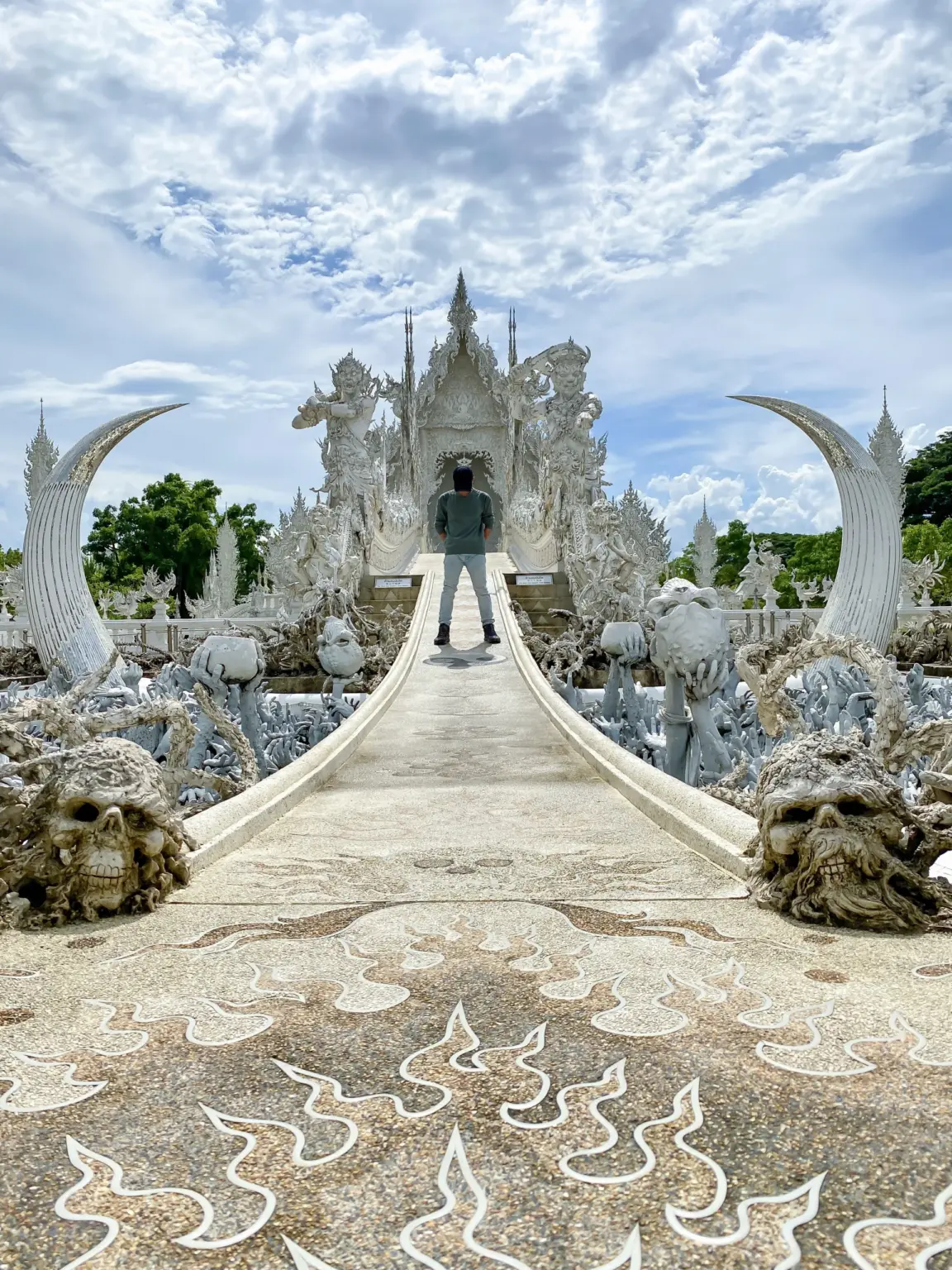
11. The Guardians
The two Guardians at the end of the Bridge are Death and Rahu. Two deities who decide the fate of the dead.
In Hinduism, Rahu is often depicted as a malevolent deity; however in Buddhism, Rahu can be considered a protective deity. Rahu is often depicted as a fierce figure, capable of warding off evil and protecting those who seek his help.
On the other side of the Bridge, Death is not seen as a malevolent force, but rather as a natural part of the cycle of existence. Death is viewed as a transition from one state of being to another, and it is seen as an opportunity for spiritual transformation.
Symbolically, they represent the protective forces that guide us on the path towards enlightenment. Although the figures of Death and Rahu may seem intimidating, they are meant to inspire us to overcome our fears.
12. The Gate of Heaven
The Gate of Heaven represents the entrance to the realm of enlightenment. The gate serves as a reminder that the path towards enlightenment may be difficult, but the rewards of spiritual liberation are well worth the effort.

13. The Ubosot
The Ubosot, or the main temple, is an unconventional interpretation of classic Thai architecture. The use of white color and fragments of mirrored glass in the building’s exterior create a sophisticated appearance, while the three-tiered roof and abundant use of Naga serpents reflect traditional Thai architectural elements.
The interior of the Ubosot is notable for its striking murals. The images of nuclear warfare and terrorist attacks is meant to represent the destructive impact that humans have had on the earth.
While the superheroes such as Superman and Batman represent the false heroes of modern society who are unable to solve the world’s problems. It’s pretty deep if you think about it.
14. The Golden Toilet
The famous Golden Toilet is inside a temple-like golden building which represents the body, while the white temple represents the mind.
Hailed as the most beautiful restroom in the world, the Golden Toilet is a commentary on the dangers of materialism.
15. The Crematorium
The Crematorium is not a functional cremation facility but serves as a symbolic representation of the impermanence of life and the Buddhist philosophy of non-attachment. As in it’s meant to instill in us that all things are impermanent, and that the pursuit of worldly desires and attachments can lead to suffering.
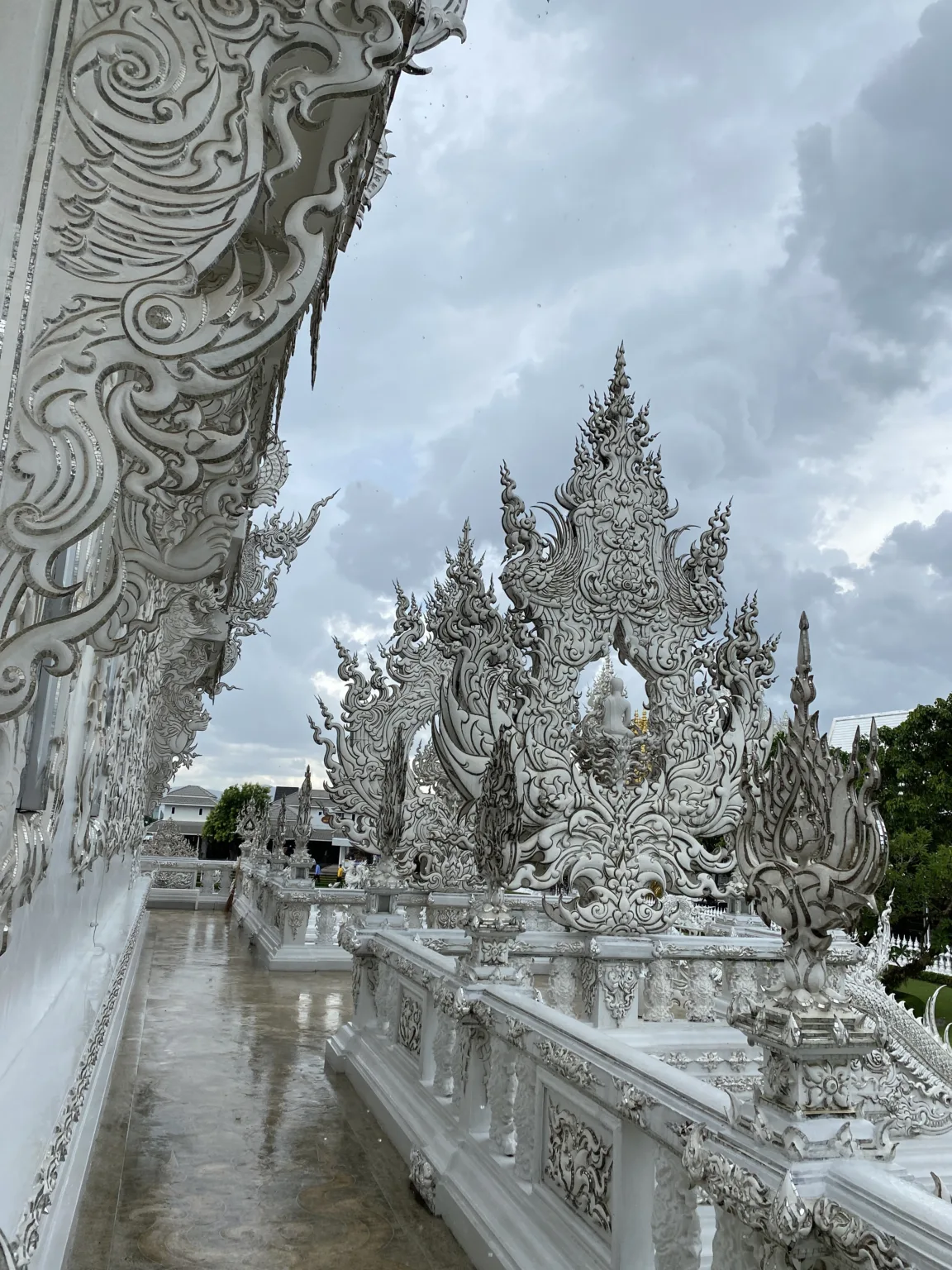
When is the Best Time to Visit the White Temple?
The best time of day to visit the White Temple is around golden hour, a bit later in the afternoon. During this time, you can get the opportunity to witness the temple’s white facade illuminated by the setting sun, creating just the most dazzling sight as it paints the temple in heavenly colors.
Note, that the temple is open until 6 PM, so while you can’t enter the main hall, you can still explore the surroundings and admire it from afar which is exactly what you should do during this time! In addition, there won’t be anyone in your shots so I recommend going later in the day to explore the interior and sticking around until sunset to get amazing shots.
Early in the morning is also a good choice as the temple is already open at 8:00 AM. The temperature is much cooler, and the light is softer, with the added advantage of avoiding the crowds.
Meanwhile, the best months to visit the White Temple is during the dry season, which typically runs from November to February.
How Long to Spend in the White Temple?
Around 1-2 hours is more than enough time to spend visiting the White Temple complex. The route is actually just one way so you can’t turn back once you start. For the rest of the time, you can spend either taking photos around the temple’s perimeter or the various facilities around the area.
There are also some cafes near the temple that can provide refreshments and wi-fi if you need it as we didn’t have any sim card to call us a cab at that time.
Plan Your Trip to Chiang Rai | Best Travel Resources
Book Your Accommodations
- Booking.com – the world’s leading online booking platform for accomodations around the world, they have an extensive amount of available listings with zero booking fees and best price guarantees.
- Hostelworld – a backpacker’s best friend, Hostelworld has the largest collection of hostels and guesthouses for affordable prices.
Don’t Forget Insurance
- SafetyWing – from Nomad Insurance, an insurance by nomads for nomads. They understand our lifestyle well and have really comprehensive and flexible plans that cater to any traveler.
Find Cheap Flights
- Kiwi.com – my go-to for booking and finding the cheapest flights and it’s helped me save tons of money. They do virtual interlining which is connecting flights from airlines that do not codeshare, so you can find routes that you wouldn’t be able to find normally.
Join Tours & Activities
- GetYourGuide – is one of the best places to find unique tours and activities. I found that it’s an excellent way to meet fellow travelers and create fond memories. They are not only limited to tours as they also offer niche services such as skip-the-line tickets or private transfers.
Catch a Ride
- Rentalcars.com – nothing beats the freedom of the road, Rentalcars.com is the world’s largest online car rental service. They operate across 160 countries so they’re the perfect partner to work with if you find yourself wanting a ride.

